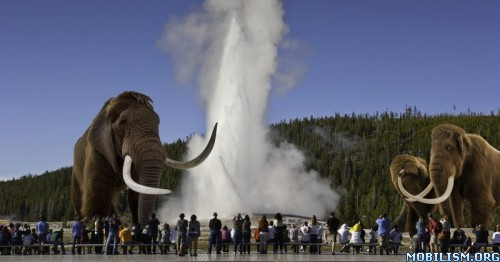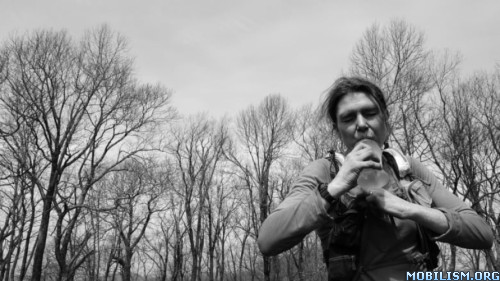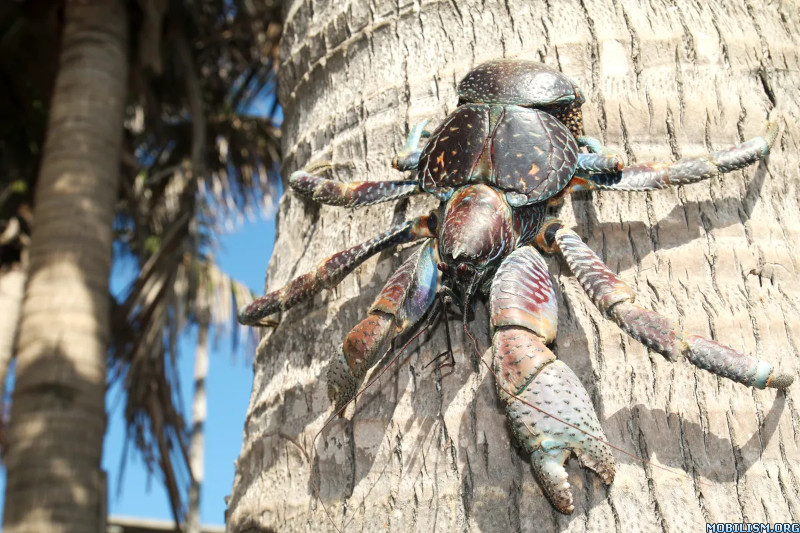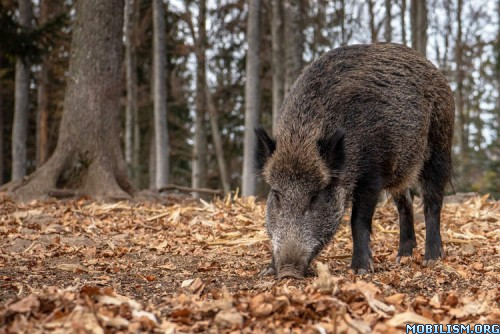Woolly Mammoths In Yellowstone? Biotech Company Says It Has The TechnologyBiotech company Colossal Biosciences has announced plans to bring back the extinct woolly mammoth by 2028. They think Yellowstone could be a good place for reintroduction as the environment is pristine and isolated enough for them to thrive.
AR
Andrew Rossi
April 27

This illustration generated by PhotoShop's artificial intelligence generator shows what it could look like if prehistoric wooly mammoths were introduced into Yellowstone National Park. (Cowboy State Daily Illustration by Greg Johnson)
If returning the Greater Yellowstone Ecosystem’s native species is truly a priority, the nation’s first national park would be teeming with more than grizzly bears, wolves and huge bison with prehistoric genes.
There also would be a thriving population of giant mammoths calling the ecosystem home.
And if a group of ambitious genetic scientists have anything to say about it, Yellowstone tourists will one day have to navigate mammoth jams on their trips through the park along with its majestic bison and bears.
That now-extinct mammoths could have a future home in Yellowstone isn’t just a sci-fi fantasy, it could happen. But whether it should is a conundrum as hairy as the prehistoric pachyderms, and some scientists think that concept should be kept on ice.
Colossal Biosciences surprised many with its recent commitment to “resurrect” the woolly mammoth by 2028. After years of research, Colossal believes it has the technology to bring back the extinct species by creating viable hybrid calves of mammoths and modern elephants.
But Colossal claims it isn’t doing such complex science solely to achieve another scientific milestone for humanity. Once resurrected, the company hopes to integrate the mammoth hybrids into existing ecosystems and resume the ecological roles they filled before their extinction.
There aren’t many pristine environments where resurrected woolly mammoths could thrive since most of their habitat has been lost to a warming planet since the ice age and human civilization over the past 20,000 years. However, one possible place might be the 3,472-square-mile corner of northwest Wyoming.
Call Of The Wild
Regarding the logistics of resurrecting woolly mammoths, Colossal’s team of scientists and supporters have spent several years and millions of dollars figuring it out. They’re so confident in their success that they’ve set a deadline.
“We believe we are currently on track for a 2028 birthing,” Ben Lamm, CEO and co-founder of Colossal, told Cowboy State Daily. “We recently were able to create an elephant iPSCs (stem cells) that is a global, world-first breakthrough and a significant step toward our woolly mammoth project. Colossal is also in the editing in the elephant cell phase of the project and leveraging the knowledge gained from the computational analysis of our now 60 mammoth genomes.”
In October 2021, Colossal finished assembling complete genomes for extant Asian and African elephants, a significant step since mammoths and Asian elephants share 99.6% of the same DNA.
Colossal intends to alter elephant iPSCs to carry mammoth DNA, then grow a mammoth-elephant hybrid in artificial wombs or elephant surrogates. The result will be a living animal that physically and genetically resembles an extinct woolly mammoth.
were introduced into Yellowstone National Park. (Cowboy State Daily Illustration by Greg Johnson)
A Real Jurassic Park?
But then what?
Lamm said the first mammoth hybrids will be kept “in a state-of-the-art, secure, animal-certified private nature preserve under the care of leading animal care professionals and elephant specialists.”
“We are focused on ensuring the health and well-being of mammoth calves from infancy through adulthood,” he said. “As we monitor their health and happiness, we will be able to make more decisions about when and how to bring in new generations. In this special location they can be allowed to grow and develop in a safe, respectful and secure environment while preparing to graduate to rewilding sites.”
“Rewilding” is Colossal’s ultimate goal. Lamm said the company wants its mammoths and other resurrected animals to function and thrive in the real world, filling the ecological roles left vacant since their extinction.
“Our long-term goal for all of our rewilding projects is to create self-sufficient, sustainable populations back in the wild,” he said. “Colossal is working with numerous conservation partners, indigenous people groups, and agencies to develop plans for the reintroduction of our rebuilt de-extinct species to their natural habitats.”
The entire state of Wyoming is within the historic ranges of mammoths. Does that mean it could be within their future range?
Wyoming’s Mammoths
Despite their prehistoric reputation, mammoths existed in distant human memory. They were roaming Wyoming as recently as 13,000 years ago.
Todd Surovell is an archaeologist and director of the Frison Institute at the University of Wyoming who has worked at the famous La Prele Mammoth Site in Converse County. He recently published a paper on a 13,000-year-old bone bead found at La Prele, where prehistoric people butchered a mammoth carcass.
From his perspective, the landscape of modern-day Wyoming is pretty similar to what it was 13,000 years ago. The biggest difference is the lack of giant mammals, like mammoths and mastodons.
“When the first people arrived, there would have been horses, camels, peccaries and various carnivores like direwolves, cheetahs, lions, giant short-faced bears and giant ground sloths,” he said. “That would have been the most noticeable difference about Wyoming 13,000 years ago.
“But ecologically, if you're looking at like the landscape, the plant communities would have been pretty similar.”
Dr. Julie Meachen is a mammalian biologist who specializes in paleoecology. Her extensive career studying Pleistocene mammals includes excavations and research in the famous Natural Trap Cave outside Lovell.
The limestone cave in the Bighorn Mountains contains the bones of many extinct North American megafauna, including American cheetahs and lions, short-faced bears, camels and mammoths. Cold conditions inside the cave keep the bones so well preserved that prehistoric DNA has been extracted and studied.
Based on her research at Natural Trap Cave and elsewhere, Meachen also believes that the Wyoming landscape today is essentially the same as it was during the last days of the mammoths. In theory, mammoths could quickly make themselves at home in Yellowstone.
“These are animals adapted to an open habitat,” she said. “The ecosystem is similar enough to what they had back in the Pleistocene that I don't think the ecosystem itself would be an issue.”
But there’s already an elephant in the room: No woolly mammoth specimen has been found in fossil-rich Wyoming. All the mammoths discovered so far are Columbian mammoths, a closely related species that was considerably larger.
“Overall, elephants are smaller than mammoths,” she said. “Modern elephants are probably about the size of a woolly mammoth, but a Columbian mammoth is significantly bigger than an elephant.
Woolly mammoths didn’t live in perpetually snowy environments but were adapted to a specific ecosystem that could get quite chilly. Woolly mammoths might struggle in modern-day Yellowstone, and resurrecting the ideal environment could be an even more mammoth task.
Steppe Back
Fred Lacombat is a paleontologist who specializes in cold-adapted fauna. His research has taken him across Siberia's frozen landscapes to examine the carcasses of frozen ice age megafauna. He even led a team of researchers scanning and autopsying baby mammoths.
Lacombat said woolly mammoths lived in a specific prehistoric biome called “the mammoth steppe.” This ecosystem was once the planet's largest and most expansive, stretching across the entire Northern Hemisphere.
“They used to live in a cool and dry climate,” he said. “The environment was crucial for them. They used to migrate seasonally in large herds in the mammoth steppe and could find all the different plants that they needed to live in large quantities.”
At its peak, the steppe would have resembled a vast grassland covered with grasses, herbs and other high-productivity plants. For roughly 100,000 years, mammoths shared that environment with extant species like brown bears, reindeer, wolves and antelope, along with extinct cave lions and woolly rhinos.
Given this description, there could be plenty of things mammoths would find familiar in Yellowstone. Even modern-day bison are close relatives of the extinct steppe bison that occupied the mammoth steppe 20,000 years ago.
Despite this, Lacombat is skeptical that mammoths could find a happy, healthy home in Yellowstone.
“Yellowstone is a wonderful place for animals to live, but you can’t find a real steppe (environment) there,” he said. “This type of mammoth steppe is not found today.”
There’s also the significantly hairy issue posed by woolly mammoths.
Woolly mammoths were probably genetically similar to Columbian mammoths, as there’s evidence the two species hybridized before their extinction. But Columbian mammoths were considerably less hairy, an adaptation for life in warmer climates.
Meachen still believes mammoths could sustain themselves in Yellowstone, but the long hair of a resurrected woolly mammoth would be a hot-button issue.
“I don't know what their temperature threshold is,” she said. “Nobody does. That’s up in the air. It’s unclear whether a woolly would do OK in the Yellowstone Ecosystem, especially today with climate change. Fifty or 100 years ago? Maybe, but I don’t know about today.”
Steppe Up
Lamm said Colossal recognizes that its woolly mammoths won’t survive without a thriving mammoth steppe. That’s why they’re working so hard to resurrect the mammoth and return it to the wild.
“The mammoth’s massive size, thunderous gait and vast migration patterns were active benefactors in preserving the health of the Arctic region,” he said. “The Mammoth Steppe was once the world’s largest ecosystem, home to millions of large herbivores. And these animals were key to protecting an ecosystem so vast.”
Lamm said that the total mass of plants and animals in Siberia’s tundra today is 100-fold less than when it was a steppe. He cited the extinction of mammoths as the primary reason for that.
“The loss of these large cold-tolerant mammoths over the past 10,000 years has stripped this ecosystem of the grasslands,” he said. “There are mossy forests and wetlands, which aren’t as helpful with combating rising temperatures.”
That touches on one of Colossal’s primary goals. Resurrecting the mammoth and the steppe could be a permanent, natural solution to reducing climate change.
“If the Mammoth Steppe ecosystem could be revived it could help reverse the rapid warming of the climate and, more pressingly, protect the Arctic’s permafrost — one of the world’s largest carbon reservoirs,” Lamm said.
As for Yellowstone, Lamm wouldn’t say whether the first national park is being considered as a rewilding location for mammoths.
“We are currently exploring many environments for potential rewilding but have not yet finalized the exact locations,” he said. “This rewilding planning process will take years and has to be done thoughtfully with various partners across conservation, government and ingenious leaders.”
This illustration generated by PhotoShop's artificial intelligence generator shows what it could look like if prehistoric wooly mammoths were introduced into Yellowstone National Park.
People Vs. Pachyderms
When facing the question of a hypothetical future with mammoths in Yellowstone, many scientists believe the Greater Yellowstone Ecosystem could absorb their return without much trouble.
Meachen speculated the transition could be “completed” within a single lifetime, citing the reintroduction of wolves as a relevant, modern-day comparison.
“When wolves were reintroduced in the 1990s, things went back to the ‘normal’ ecosystem within 10 years,” she said. “If mammoths were left to their own devices — unmolested, and this is always the caveat — I would say habitats would probably be restored within 20 to 40 years.”
Meachen has a strong opinion about mammoths in Yellowstone’s future, and it’s not optimistic.
“I think it would be a catastrophe,” she said. “I don't think the ecosystem will have trouble absorbing mammoth, but it could have serious consequences for the human environment.”
Meachen has studied modern elephants in the wild and knows enough about their behavior to see dozens of mammoth-sized issues. Elephants are more than willing to use their size and strength to get what they want, and there isn’t much people can do to dissuade them.
It’s not hard to find examples of the destruction wrought by a single 5-ton male elephant, let alone a herd of multiple, multi-ton animals on the same wavelength.
Woolly mammoths, let alone Wyoming’s endemic Columbian mammoths, would make that potential even bigger and badder. Lacombat estimated that a sustainable population of breeding mammoths, as was done with wolves in Yellowstone, would need at least 200 animals.
Meachen can already envision the absolute havoc mammoths could cause inside and outside Yellowstone. She believes anyone living adjacent to the park would “have an absolute, catastrophic heart attack if elephants were going to be unleashed in their neighborhoods.”
“I can see giant herds of mammoths stampeding through West Yellowstone, stomping on cars and bowling through buildings,” she said. “It would be an absolute catastrophe. You have to remember that an elephant's home territory is probably bigger than the park, and they probably wouldn’t give a damn if the boundaries were not sufficient for their roaming needs.”
Double Jeopardy
Woolly mammoths roamed the Northern Hemisphere until around 12,000 years ago when the Mammoth Steppe started declining worldwide. Paleontologists and archaeologists still debate the reasons for this decline.
Lacombat said it’s no coincidence that mammoths and many other ice age creatures went extinct once their environment began to disappear.
“Climate warming reduced the area where steppe mammoths could be found,” he said. “They became isolated in smaller areas, and then it was more difficult for them to have genetic interbreeding. In addition, the pressure of human hunting increased in certain places. These two parameters probably reduced the population, leading in the long term to its extinction.”
Today, the steppe is a shadow of itself. The eastern Altai-Sayan mountains of central Eurasia are cited as the closest analog to the prehistoric biome, and many species that formerly lived there still exist today.
The leading theories for what caused the Late Pleistocene extinctions of mammoths and many other large North American mammals are climate change and humans. While scientists argue over the extent of humanity’s role in the extinction, most believe they had a significant impact.
“I believe very strongly that if humans had never colonized the Americas, there would still be mammoths living here today,” Surovell said. “I believe that mammoth extinction worldwide was largely driven by human hunting. This is a very contentious topic in archaeology, but to me, it’s rather unambiguous.”
A 2023 study of the La Brea Tar Pits in Los Angeles, California, found high quantities of charcoal in the sediment, likely from fires caused by the migration and settlement of prehistoric people. That discovery led researchers to conclude that human habitation, rather than hunting, was the leading cause of mammoth extinction.
Meachen was one of the scientists leading the 2023 La Brea study. She said humans were modifying their prehistoric habitat to such a degree that it immensely impacted animals, particularly large mammals like mammoths.
“I think the major cause of the extinction was a combination of large-scale climate change and habitat modification by humans,” she said. “It’s just like that today. Habitat modification is the No. 1 reason animals go extinct today. We eradicate natural habitats today, and that was happening at the end of the last ice age, too.”
This perspective contributes to Meachen and Surovell’s skepticism that mammoths could successfully and sustainably survive in modern-day Yellowstone.
“I can't imagine that this wouldn't present a serious issue,” Meachen said. “Humans would want to kill these things immediately, and I don't think the mammoths would stand a chance. It's a tragedy waiting to happen for both the mammoths and humans.”
“Mammoths would just do just fine (in Yellowstone) if we allowed them to,” Surovell added. “But we allow these animals to exist. If we didn't regulate the hunting of pronghorn or elk, I feel very strongly that those things would not exist anymore.”
Can, But Should?
Despite the informed pessimism expressed by paleontologists, archaeologists, biologists and many other scientific minds in the 21st century, the modern world seems poised to witness the return of the woolly mammoth.
And even the pessimists aren’t immune to the childlike enthusiasm of seeing a living mammoth.
“Some nights when I can't fall asleep, I sit in my tent and imagine what it would be like to hear a herd of mammoths walking by,” Surovell said. “What would it be like to drive down Interstate 80 and see a herd of mammoths off in the distance? It would be a really cool thing to go beyond imagination.”
Meachen described her first experience with a wild elephant as “absolutely breathtaking.”
“I've never had a visceral reaction to an animal like I did to an elephant in the wild,” she said. “They are incredible. So, I understand the feelings of wanting to resurrect mammoths. I understand the excitement.”
However, the philosophical boundaries of human civilization often check the enthusiasm for science. The ultimate issue in the debate over de-extinction was queried by the character Ian Malcolm in the 1993 film “Jurassic Park”: science can, but that doesn’t mean humanity should.
Even in the vast Greater Yellowstone Ecosystem, mammoths would still be confined to the invisible boundaries erected by human civilization. In Yellowstone National Park, their existence would be beholden to people's permissiveness.
Humanity contributed to the extinction of the mammoths in the distant past. If so tempted, they could contribute to their extinction again in the future.
“Don't get me wrong, I would love to see a living mammoth once in my life,” Lacombat said. “But what is the goal? It will cost millions and millions to bring back a prehistoric species, and while I’m sure it will be studied, it might only become a tourist attraction. Putting woolly mammoths in an open cage is not something I like to think about.”

































